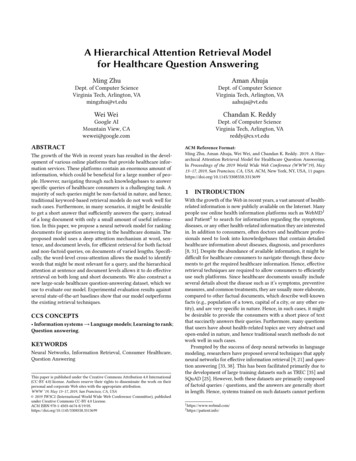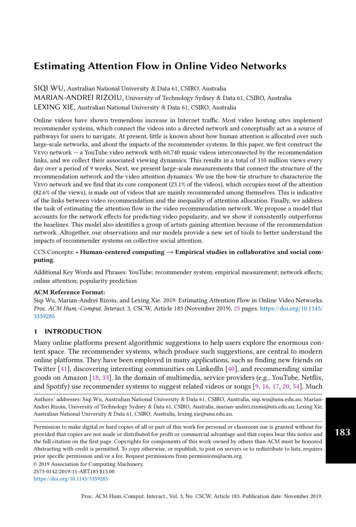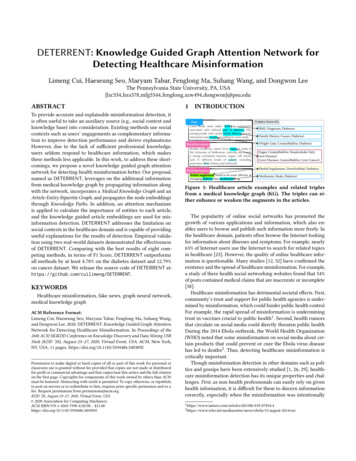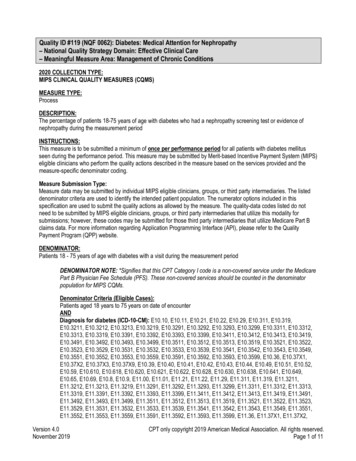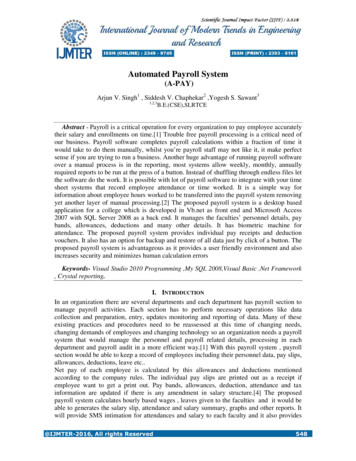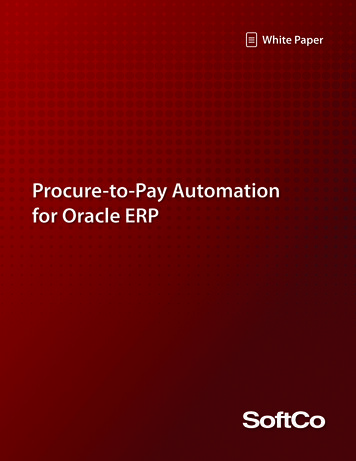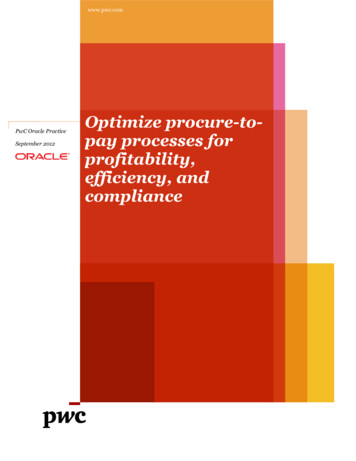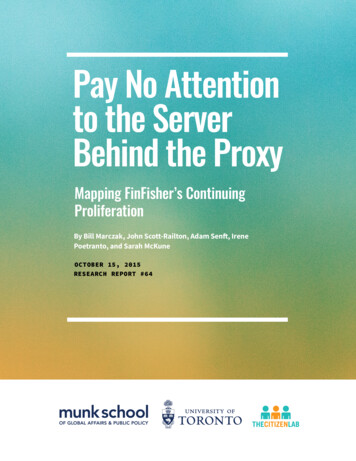
Transcription
Pay No Attentionto the ServerBehind the ProxyMapping FinFisher’s ContinuingProliferationBy Bill Marczak, John Scott-Railton, Adam Senft, IrenePoetranto, and Sarah McKuneOCTOBER 15, 2015RESEARCH REPORT #64
Copyright The Citizen LabLicensed under the Creative Commons BY-SA 4.0 (Attribution-ShareAlikelicence). Electronic version first published in 2015 by the Citizen Lab. Thiswork can be accessed through ntinuing-proliferation/.Document Version: 1.0The Creative Commons Attribution-ShareAlike 4.0 license under which thisreport is licensed lets you freely copy, distribute, remix, transform, andbuild on it, as long as you: give appropriate credit; indicate whether you made changes; and use and link to the same CC BY-SA 4.0 licence.However, any rights in excerpts reproduced in this report remain withtheir respective authors; and any rights in brand and product names andassociated logos remain with their respective owners. Uses of these thatare protected by copyright or trademark rights require the rightsholder’sprior written agreement.Suggested CitationBill Marczak, John Scott-Railton, Adam Senft, Irene Poetranto, and SarahMcKune. “Pay No Attention to the Server Behind the Proxy: Mapping FinFisher’sContinuing Proliferation,” Citizen Lab Research Report No. 64, University ofToronto, October 2015.
AcknowledgementsSpecial thanks to Citizen Lab colleagues Morgan Marquis-Boire and ClaudioGuarnieri, as well as Ron Deibert and Masashi Crete-Nishihata. Special thanks tothe Open Technology Fund. Thanks to Vern Paxson and Jason Passwaters.About the Citizen Lab, Munk School of Global Affairs andPublic Policy, University of TorontoThe Citizen Lab is an interdisciplinary laboratory based at the Munk Schoolof Global Affairs and Public Policy, University of Toronto, focusing on research,development, and high-level strategic policy and legal engagement at theintersection of information and communication technologies, human rights, andglobal security.We use a “mixed methods” approach to research that combines methods frompolitical science, law, computer science, and area studies. Our research includesinvestigating digital espionage against civil society, documenting Internet filteringand other technologies and practices that impact freedom of expression online,analyzing privacy, security, and information controls of popular applications,and examining transparency and accountability mechanisms relevant to therelationship between corporations and state agencies regarding personal dataand other surveillance activities.
ContentsExecutive Summary5Part 1: Fishing for FinFisher7Okay Google, What is my IP?How's the Weather in Caracas?Other DecoysGeneral CommentsPart 2: Country FindingsAttribution to Specific EntitiesBangladeshDirectorate General of Forces Intelligence (DGFI)BelgiumFederal Police ServiceSerbiaSecurity Information Agency (BIA)EgyptTechnology Research DepartmentIndonesiaNational Encryption Body (Lembaga Sandi Negara)KenyaNational Intelligence ServiceLebanonGeneral Directorate of General SecurityInternal Security ForcesMoroccoConseil Superieur De La Defense Nationale (CSDN) /Supreme Council of National DefenseMongoliaState Special Security Department (SSSD)Part 3: A Deeper Analysis of Several CasesEgypt: Use of FinFisher illuminates connections betweendifferent groupsMOLERATS Attacks with FinFisherThe Curious Case of the Shared ExploitFinFly Web in the WildItaly: Shift from Hacking Team to FinFisher?Oman: Eagle Eye Digital Solutions LLCConclusionThe Global Intrusion Software Market: Difficult to Study,Tricky to RegulateAppendix A: List of FinFisher 2232324242425262828292931
CITIZEN LAB RESEARCH REPORT NO. 64This post describes the results of Internet scanning we recently conductedto identify the users of FinFisher, a sophisticated and user-friendly spywaresuite sold exclusively to governments. We devise a method for queryingFinFisher’s “anonymizing proxies” to unmask the true location of thespyware’s master servers. Since the master servers are installed on thepremises of FinFisher customers, tracing the servers allows us to identifywhich governments are likely using FinFisher. In some cases, we can tracethe servers to specific entities inside a government by correlating our scanresults with publicly available sources. Our results indicate 32 countrieswhere at least one government entity is likely using the spyware suite,and we are further able to identify 10 entities by name. Despite the 2014FinFisher breach, and subsequent disclosure of sensitive customer data,our scanning has detected more servers in more countries than ever before.Executive SummaryFinFisher is a sophisticated computer spyware suite, written by Munich-basedFinFisher GmbH, and sold exclusively to governments for intelligence and lawenforcement purposes. Although marketed as a tool for fighting crime,1 the spywarehas been involved in a number of high-profile surveillance abuses. Between 2010and 2012, Bahrain’s government used FinFisher to monitor some of the country’stop law firms, journalists, activists, and opposition political leaders.2 Ethiopiandissidents in exile in the United Kingdom3 and the United States4 have also beeninfected with FinFisher spyware.In 2012 and 2013, Citizen Lab researchers and collaborators,5 published severalreports analyzing FinFisher spyware, and conducted scanning that identifiedFinFisher command and control (C&C) servers in a number of countries. In ourprevious research, we were not yet able to differentiate between FinFisheranonymizing proxies and master servers, a distinction that we make in this /kidane-v-ethiopia5See ve-finfishers-spy-kit-exposed/, oved-me-finfisher-goes-mobile/, -finfishers-global-proliferation-2/, 2/, g/2012/08/08/finfisher5
PAY NO ATTENTION TO THE SERVER BEHIND THE PROXYWhen a government entity purchases FinFisher spyware, they receive a FinSpyMaster—a C&C server that is installed on the entity’s premises.6 The entity maythen set up anonymizing proxies (also referred to as “proxies” or “FinSpy Relays”in the FinFisher documentation), to obscure the location of their master. Infectedcomputers communicate with the anonymizing proxy, which is “usually”7 set up ona Virtual Private Server (VPS) provider in a third country. The proxy then forwardscommunications between a victim’s computer and the Master server.We first describe how we scanned the Internet for FinFisher servers and distinguishedmasters from proxies (Part 1: Fishing for FinFisher). We then outline our findingsregarding 32 governments and 10 specific government entities that we believe areusing FinFisher (Part 2: Country Findings). Finally, we highlight several cases thatilluminate connections between different threat actors (Part 3: A Deeper Analysisof Several Cases), before concluding ments/FinSpy-3.10-Specifications.doc7Id.6
CITIZEN LAB RESEARCH REPORT NO. 64Part 1: Fishing for FinFisherIn this section, we describe our scans for FinFisher servers, and how we unmasked thetrue location of the master servers to identify governments using FinFisher.Each FinFisher sample includes the address of one or more C&C servers that thespyware reports back to. These C&C servers are typically FinSpy Relays, whichforward connections back and forth between a device infected with FinFisher, anda FinSpy Master. The purpose of the FinSpy Relay is explicitly to make it “practicallyimpossible” (their emphasis) for a researcher to discover “the location and countryof the Headquarter [sic]”.8Figure 1: How targets infected with FinFisher communicate with the FinSpy Master via one ormore FinSpy Relays.9We employed zmap10 to scan the entire IPv4 Internet (/0) several times since the endof December 2014 and throughout 2015, using a new FinFisher server fingerprintthat we devised by analyzing FinFisher samples. Our scans yielded 135 serversmatching our fingerprint, which we believe are a mix of FinSpy Masters and FinSpyRelays.When one queries a FinFisher server, or types the server’s address into a webbrowser, the server typically returns a decoy page. A decoy page is a page designedto disguise the fact that the server is a spyware server. We found some variation inthe decoy pages used by FinFisher servers that we detected, though the bulk usedeither www.google.com or www.yahoo.com. Peculiarly, FinSpy Relays appearto return decoy pages fetched by their FinSpy Master, rather than directly 0/289 GAMMA-201110-FinSpy.pdf10https://zmap.io/7
PAY NO ATTENTION TO THE SERVER BEHIND THE PROXYthe decoy pages themselves. Thus, in many cases, the pages returned by theFinSpy Relays contain location data apparently about the FinSpy Master (e.g.,certain Google and Yahoo pages embed the requester’s IP address or localizedweather), which can reveal the location of FinSpy Masters.Okay Google, What is my IP?We noticed that when we issued a query like “What is my IP address?” to a Googledecoy FinFisher server, the server would respond with a different IP address. Inthe case below, a FinFisher server 206.190.159.xxx (located in the United States)reported that its IP address was the Indonesian IP 112.78.143.xxx, which matches aFinFisher server first detected in August 2012 by Claudio Guarnieri.11 We hypothesizethat 206.190.159.xxx is a FinFisher proxy, designed to obscure the location of theFinFisher master, which is at 112.78.143.xxx.Figure 2: A FinFisher server in the US seems to be a proxy for a master in Indonesia.Specifically, we sent queries of the form:GET /search?q my ip address&nord 1 HTTP/1.1Host: [ip of server]User-Agent: Mozilla/5.0 (Windows NT 6.1; rv:38.0) Gecko/20100101 Firefox/38.0Figure 3: Queries we sent to Google-decoy FinFisher servers to reveal the IP address of themaster.12The fact that FinFisher proxies can apparently reveal the IP of the master is quitepeculiar. We illustrate below how we believe a query like “What is my IP address?”is routed through FinSpy Relays to the FinSpy fosec/blog/2012/08/08/finfisher12Google does not return the user’s IP address unless a certain type of “User-Agent” header is included. In this example, we include a user agent used by the Tor Browser Bundle. The “nord 1”parameter turns off Google’s SSL redirection.8
CITIZEN LAB RESEARCH REPORT NO. 64Figure 4: How we believe a “What is my IP address?” query is routed through FinSpy Relays toa FinSpy Master.It appears that the “What is my IP Address?” query is delivered from our MeasurementMachine by the FinSpy Relay to the FinSpy Master, and then submitted to Googleby the FinSpy Master. Therefore, Google returns the IP address of the FinSpyMaster, which is then sent back to the Measurement Machine via the FinSpy Relay.How's the Weather in Caracas?A significant number of FinFisher servers we detected used www.yahoo.com astheir decoy page. While we were unable to devise a method to find the exact IPaddress of Yahoo-decoy FinFisher endpoints, we were still able to retrieve locationinformation from Yahoo, by examining the userLocation object in the decoy page’ssource code. Yahoo utilizes a user’s location to customize several elements ofYahoo’s homepage, including weather and news.Figure 5: Weather conditions in Caracas returned by a FinFisher server in Lithuania.The userLocation object returned by 185.8.106.xxx (located in Lithuania) is shownbelow:9
PAY NO ATTENTION TO THE SERVER BEHIND THE ","city":"Caracas","state":"Distrito .}Figure 6: A FinFisher server in Lithuania seems to be a proxy for a master in Venezuela.The userLocation object allows us to obtain city and country information forFinFisher endpoints, though we cannot determine their precise IP address. Weissued a query similar to the following to each Yahoo-decoy FinFisher server toobtain a page with the userLocation object:GET https://www.yahoo.com/ HTTP/1.1Host: www.yahoo.comUser-Agent: Mozilla/5.0 (Windows NT 6.1; rv:38.0) Gecko/20100101 Firefox/38.0Figure 7: Queries we sent to Yahoo-decoy FinFisher servers to reveal the location of themaster.13Since Yahoo, like Google, implements SSL redirection by default, we had to devisea method to talk to Yahoo in plain HTTP. While Google provides the “nord 1” URLparameter to avoid SSL redirection, Yahoo apparently does not have an analogouspublicized solution. However, we found that by sending plain HTTP GET requests tothe resource “https://www.yahoo.com/” we could communicate with www.yahoo.com in plain HTTP without triggering SSL redirection.Other DecoysWhile the majority of FinFisher servers we detected used either Google or Yahooas a decoy page, we identified a number of other servers whose operators hadapparently customized the decoy page to a different URL.One server used the Italian news source libero.it as a decoy. We noted that libero.itsets the “Libero” cookie, which contains the IP address of the computer that visitedthe libero.it website. When accessing 185.8.106.xxx, the Libero-decoy FinFisherserver, the cookie was set to include the Italian IP 93.146.250.xxx.14 Servers that we13Yahoo does not return the userLocation object unless a certain type of “User-Agent” header isincluded. In some cases, we needed to substitute a countr
the case below, a FinFisher server 206.190.159.xxx (located in the United States) reported that its IP address was the Indonesian IP 112.78.143.xxx, which matches a FinFisher server first detected in August 2012 by Claudio Guarnieri.11 We hypothesize that 206.190.159.xxx is a FinFisher proxy, designed to obscure the location of the
